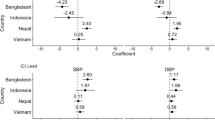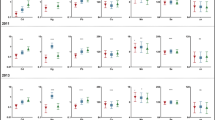Abstract
Exposure to metal pollution can be caused from inhalation, ingestion, or absorption from air, water, or food. Chronic exposure to trace amounts of metals can lead to high blood pressure, or hypertension, and other chronic diseases. The rationale of our study was to determine if there was a correlation between nineteen forms of urinary metal concentrations and high blood pressure, defined as ≥ 130 mm Hg systolic or ≥ 80 mm Hg diastolic, in the adult US population, to understand the possible impacts of metal exposure on humans. Five types of urinary arsenic species and fourteen types of urinary metals were studied to examine their correlation with high blood pressure. We used the dataset from the 2015–2016 National Health and Nutrition Examination Survey (NHANES) for the study. A specialized complex survey design analysis package was used in analyzing the NHANES data. We used pairwise t tests and the logit regression models to study the correlation between urinary arsenic (five types) and urinary metal (fourteen types) concentrations and high blood pressure. The total study population analyzed included 4037 adults aged 20 years and older, of whom 57.9% of males and 51.7% of females had high blood pressure. Urinary arsenous acid (OR: 2.053, 95% CI: 1.045, 4.035), tin (OR: 1.983, 95% CI: 1.169, 3.364), and cesium (OR: 2.176, 95% CI: 1.013, 4.675) were associated with increased odds of high blood pressure. The other four types of urinary arsenic and twelve types of urinary metals were not associated with high blood pressure. Our results determined that exposure to environmental metals such as arsenous acid, tin, and cesium can be associated with high blood pressure. Further investigation is suggested to support our findings.
Similar content being viewed by others
References
Abhyankar LN, Jones MR, Guallar E, Navas-Acien A (2012) Arsenic exposure and hypertension: a systematic review. Environ Health Pers 120(4):494–500. https://doi.org/10.1289/ehp.1103988
American Heart Association (AHA). (2019). AHA High Blood Pressure Toolkit. http://aha-clinical-review.ascendeventmedia.com/books/aha-high-blood-pressure-toolkit/16/
Caldwell KL, Jones RL, Verdon CP, Jarrett JM, Caudill SP, Osterloh JD (2009) Levels of urinary total and speciated arsenic in the US population: National Health and Nutrition Examination Survey 2003–2004. J Exposure Sci Environ Epidemiol 19(1):59–68. https://doi.org/10.1038/jes.2008.32
CDC. (2017a). About the National Health and Nutrition Examination Survey. https://www.cdc.gov/nchs/nhanes/about_nhanes.htm
CDC. (2017b). National Health and Nutrition Examination Survey, 2015–2016 Data documentation, codebook, and frequencies, blood pressure (BPX_I). https://wwwn.cdc.gov/Nchs/Nhanes/2015–2016/BPX_I.htm
CDC. (2017c). National Health and Nutrition Examination Survey, 2015–2016 Data documentation, codebook, and frequencies, blood pressure & cholesterol (BPQ_I). https://wwwn.cdc.gov/Nchs/Nhanes/2015–2016/BPQ_I.htm
CDC. (2017d). National Health and Nutrition Examination Survey, 2015–2016 Data documentation, codebook, and frequencies, body measures (BMX_I). https://wwwn.cdc.gov/Nchs/Nhanes/2015–2016/BMX_I.htm
CDC. (2017e). National Health and Nutrition Examination Survey, 2015–2016 Data documentation, codebook, and frequencies, demographic variables and sample weights (DEMO_I). https://wwwn.cdc.gov/Nchs/Nhanes/2015–2016/DEMO_I.htm
CDC. (2018a). National Health and Nutrition Examination Survey, 2015–2016 Data documentation, codebook, and frequencies, speciated arsenics—urine (UAS_I). https://wwwn.cdc.gov/Nchs/Nhanes/2015–2016/UAS_I.htm
CDC. (2018b). National Health and Nutrition Examination Survey, 2015–2016 Data documentation, codebook, and frequencies, arsenic—total—urine (UTAS_I). https://wwwn.cdc.gov/Nchs/Nhanes/2015–2016/UTAS_I.htm
CDC. (2018c). National Health and Nutrition Examination Survey, 2015–2016 Data documentation, codebook, and frequencies, metals—urine—special sample (UMS_I). https://wwwn.cdc.gov/Nchs/Nhanes/2015–2016/UMS_I.htm
CDC. (2018d). National Health and Nutrition Examination Survey, 2015–2016 Data documentation, codebook, and frequencies, mercury—urine (UHG_I). https://wwwn.cdc.gov/Nchs/Nhanes/2015–2016/UHG_I.htm
CDC. (2018e). National Health and Nutrition Examination Survey, 2015–2016 Data documentation, codebook, and frequencies, alcohol use (ALQ_I). https://wwwn.cdc.gov/Nchs/Nhanes/2015–2016/ALQ_I.htm
CDC. (2019a). National Health and Nutrition Examination Survey, 2015–2016 Data documentation, codebook, and frequencies, albumin & creatinine—urine (ALB_CR_I). https://wwwn.cdc.gov/Nchs/Nhanes/2015-2016/ALB_CR_I.htm
CDC. (2019b). National Health and Nutrition Examination Survey, 2015–2016 Data documentation, codebook, and frequencies, cotinine and hydroxycotinine—serum (COT_I). https://wwwn.cdc.gov/Nchs/Nhanes/2015–2016/COT_I.htm
CDC. (2020). Defining adult overweight and obesity. https://www.cdc.gov/obesity/adult/defining.html
CDC/National Center for Health Statistics. (2020). NHANES 2015–2016. https://wwwn.cdc.gov/nchs/nhanes/ContinuousNhanes/Default.aspx?BeginYear=2015
Chen, C. J., Hsueh, Y. M., Lai, M. S., Shyu, M. P., Chen, S. Y., Wu, M. M., Kuo, T. L., & Tai, T. Y. (1995). Increased prevalence of hypertension and long-term arsenic exposure. Hypertension (Dallas, Tex. : 1979), 25(1), 53–60.
Cuschieri S, Vassallo J, Calleja N, Pace N, Mamo J (2017) The effects of socioeconomic determinants on hypertension in a cardiometabolic at-risk European country. Intl J Hyperten 2017:7107385–7107387. https://doi.org/10.1155/2017/7107385
Feng RN, Zhao C, Wang C, Niu YC, Li K, Guo FC, Li ST, Sun CH, Li Y (2012) BMI is strongly associated with hypertension, and waist circumference is strongly associated with type 2 diabetes and dyslipidemia, in northern Chinese adults. J Epidemiol 22(4):317–323. https://doi.org/10.2188/jea.je20110120
Flack JM, Adekola B (2020) Blood pressure and the new ACC/AHA hypertension guidelines. Trends Cardiovasc Med 30(3):160–164. https://doi.org/10.1016/j.tcm.2019.05.003
Fryar CD, Ostchega Y, Hales CM, Zhang G, Kruszon-Moran D (2017) Hypertension prevalence and control among adults: United States, 2015–2016. NCHS Data Brief 289:1–8 https://www.cdc.gov/nchs/data/databriefs/db289.pdf
Hallenbeck WH (1984) Human health effects of exposure to cadmium. Experientia 40(2):136–142. https://doi.org/10.1007/BF01963576
Hawkesworth S, Wagatsuma Y, Kippler M, Fulford AJ, Arifeen SE, Persson LA, Moore SE, Vahter M (2013) Early exposure to toxic metals has a limited effect on blood pressure or kidney function in later childhood, rural Bangladesh. Intl J Epidemiol 42(1):176–185. https://doi.org/10.1093/ije/dys215
Houston MC (2007) The role of mercury and cadmium heavy metals in vascular disease, hypertension, coronary heart disease, and myocardial infarction. Alter Ther Health Med 13(2):S128–S133
Interpreting Logistic ROC Curves. (n.d.). https://www.graphpad.com/guides/prism/8/curve-fitting/reg_logistic_roc_curves.htm
Jekel, M., & Amy, G. L. (2006). Chapter 11: Arsenic removal during drinking water treatment. In Interface science in drinking water treatment: theory and applications (Vol. 10, pp. 193-206). Interface Science and Technology.
Jones, M. R., Tellez-Plaza, M., Sharrett, A. R., Guallar, E., & Navas-Acien, A. (2011). Urine arsenic and hypertension in US adults: the 2003–2008 National Health and Nutrition Examination Survey. Epidemiology (Cambridge, Mass.), 22(2), 153–161. https://doi.org/10.1097/EDE.0b013e318207fdf2
Kirkland EB, Heincelman M, Bishu KG, Schumann SO, Schreiner A, Axon RN, Mauldin PD, Moran WP (2018) Trends in healthcare expenditures among US adults with hypertension: national estimates, 2003–2014. J Am Heart Assoc 7(11):e008731. https://doi.org/10.1161/JAHA.118.008731
Kobal AB, Horvat M, Prezelj M, Briski AS, Krsnik M, Dizdarevic T, Mazej D, Falnoga I, Stibilj V, Arneric N, Kobal D, Osredkar J (2004) The impact of long-term past exposure to elemental mercury on antioxidative capacity and lipid peroxidation in mercury miners. J Trace Elem Med Biol Org Soc Min Trace Elem (GMS) 17(4):261–274. https://doi.org/10.1016/S0946-672X(04)80028-2
Lan C, Liu Y, Li Q, Wang B, Xue T, Chen J, Jiangtulu B, Ge S, Wang X, Gao M, Yu Y, Xu Y, Zhao X, Li Z (2021) Internal metal(loid)s are potentially involved in the association between ambient fine particulate matter and blood pressure: a repeated-measurement study in north China. Chemosphere 267:129146. https://doi.org/10.1016/j.chemosphere.2020.129146
Lumley, T. (2004). Analysis of complex survey samples. Journal of Statistical Software, 9(8). doi:10.18637/jss.v009.i08
Lumley TS (2010) Complex surveys: a guide to analysis using R. John Wiley & Sons, Hoboken
Lumley, T. (2020). Package ‘survey’: analysis of complex survey samples, version 4.0. https://cran.r-project.org/web/packages/survey/survey.pdf
McGinnis DP, Brownstein JS, Patel CJ (2016) Environment-wide association study of blood pressure in the National Health and Nutrition Examination Survey (1999–2012). Sci Rep 6:30373. https://doi.org/10.1038/srep30373
Miao H, Liu Y, Tsai TC, Schwartz J, Ji JS (2020) Association between blood lead level and uncontrolled hypertension in the US population (NHANES 1999–2016). J Am Heart Assoc 9(13):e015533. https://doi.org/10.1161/JAHA.119.015533
Prabhakaran, S. (2016). Package ‘InformationValue’: “performance analysis and companion functions for binary classification models,” version 1.2.3. https://cran.r-project.org/web/packages/InformationValue/InformationValue.pdf
Core Team R (2020) R: a language and environment for statistical computing. R Foundation for Statistical Computing, Vienna https://www.R-project.org/
Rahman HH, Niemann D, Singh D (2020a) Arsenic exposure and association with hepatitis E IgG antibodies. Occupational Diseas Environ Med 8:111–122. https://doi.org/10.4236/odem.2020.83009
Rahman HH, Yusuf KK, Niemann D, Dipon SR (2020b) Urinary speciated arsenic and depression among US adults. Environ Sci Pollut Res Intl 27(18):23048–23053. https://doi.org/10.1007/s11356-020-08858-2
Rodrigues J, Pinto MM, Figueredo R, Lima H, Souto R, Sacchetim SC (2017) Systemic arterial hypertension in patients exposed to cesium-137 in Goiânia-GO: prevalence study. Arquivos Brasileiros de Cardiologia 108(6):533–538. https://doi.org/10.5935/abc.20170062
Shiue I (2014a) Higher urinary heavy metal, arsenic, and phthalate concentrations in people with high blood pressure: US NHANES, 2009–2010. Blood Pressure 23(6):363–369. https://doi.org/10.3109/08037051.2014.925228
Shiue I (2014b) Higher urinary heavy metal, phthalate, and arsenic but not parabens concentrations in people with high blood pressure, U.S. NHANES, 2011–2012. Intl J Environ Res Pub Health 11(6):5989–5999. https://doi.org/10.3390/ijerph110605989
Shiue I, Hristova K (2014) Higher urinary heavy metal, phthalate and arsenic concentrations accounted for 3–19% of the population attributable risk for high blood pressure: US NHANES, 2009–2012. Hyperten Res Official J Japanese Soc Hyperten 37(12):1075–1081. https://doi.org/10.1038/hr.2014.121
Susmann, H. (2016). Package ‘RNHANES’: “facilitates analysis of CDC NHANES,” version 1.1.0. https://cran.r-project.org/web/packages/RNHANES/RNHANES.pdf
Telisman S, Jurasović J, Pizent A, Cvitković P (2001) Blood pressure in relation to biomarkers of lead, cadmium, copper, zinc, and selenium in men without occupational exposure to metals. Environ Res 87(2):57–68. https://doi.org/10.1006/enrs.2001.4292
Vadakkanmarveettil, J. (2015). Sensitivity vs. specificity in logistic regression. https://www.jigsawacademy.com/sensitivity-vs-specificity-in-logistic-regression/ Oct. 2020.
Wang B, Zhu Y, Pang Y, Xie J, Hao Y, Yan H, Li Z, & Ye R (2018). Indoor air pollution affects hypertension risk in rural women in Northern China by interfering with the uptake of metal elements: a preliminary cross-sectional study. Environmental pollution (Barking, Essex : 1987), 240, 267–272. https://doi.org/10.1016/j.envpol.2018.04.097
Whelton, P. K., Carey, R. M., Aronow, W. S., Casey, D. E., Jr, Collins, K. J., Dennison Himmelfarb, C., DePalma, S. M., Gidding, S., Jamerson, K. A., Jones, D. W., MacLaughlin, E. J., Muntner, P., Ovbiagele, B., Smith, S. C., Jr, Spencer, C. C., Stafford, R. S., Taler, S. J., Thomas, R. J., Williams, K. A., Sr, Williamson, J. D., … Wright, J. T., Jr (2018). 2017 ACC/AHA/AAPA/ABC/ACPM/AGS/APhA/ASH/ASPC/NMA/PCNA Guideline for the prevention, detection, evaluation, and management of high blood pressure in adults: a report of the American College of Cardiology/American Heart Association Task Force on Clinical Practice Guidelines. Hypertension (Dallas, Tex. : 1979), 71(6), e13–e115. https://doi.org/10.1161/HYP.0000000000000065
Wu, W., Jiang, S., Zhao, Q., Zhang, K., Wei, X., Zhou, T., Liu, D., Zhou, H., Zeng, Q., Cheng, L., Miao, X., & Lu, Q. (2018). Environmental exposure to metals and the risk of hypertension: a cross-sectional study in China. Environmental pollution (Barking, Essex : 1987), 233, 670–678. https://doi.org/10.1016/j.envpol.2017.10.111
Yang AM, Lo K, Zheng TZ, Yang JL, Bai YN, Feng YQ, Cheng N, Liu SM (2020) Environmental heavy metals and cardiovascular diseases: status and future direction. Chronic Diseas Trans Med 6(4):251–259. https://doi.org/10.1016/j.cdtm.2020.02.005
Availability of data and material
The datasets analyzed during the current study are available in the NHANES repository provided by the CDC to the public [https://wwwn.cdc.gov/nchs/nhanes/ContinuousNhanes/Default.aspx?BeginYear=2015] (CDC/National Center for Health Statistics 2020).
Author information
Authors and Affiliations
Contributions
HHR conceptualized the study and contributed to the introduction and discussion. SMM conducted the data analysis and contributed to the drafting of the paper. DN contributed to the methods section and drafting of the paper. All authors read and approved the final manuscript.
Corresponding author
Ethics declarations
Ethics approval and consent to participate
Not applicable. This study uses only secondary data analyses without any personal information identified using statistical data from the NHANES website; no further ethical approval for conducting the present study is required.
Consent to participate
Consent was given by all the authors.
Competing interests
The authors declare no competing interests.
Additional information
Responsible Editor: Lotfi Aleya
Publisher’s note
Springer Nature remains neutral with regard to jurisdictional claims in published maps and institutional affiliations.
Rights and permissions
About this article
Cite this article
Rahman, H.H., Niemann, D. & Munson-McGee, S.H. Environmental exposure to metals and the risk of high blood pressure: a cross-sectional study from NHANES 2015–2016. Environ Sci Pollut Res 29, 531–542 (2022). https://doi.org/10.1007/s11356-021-15726-0
Received:
Accepted:
Published:
Issue Date:
DOI: https://doi.org/10.1007/s11356-021-15726-0




